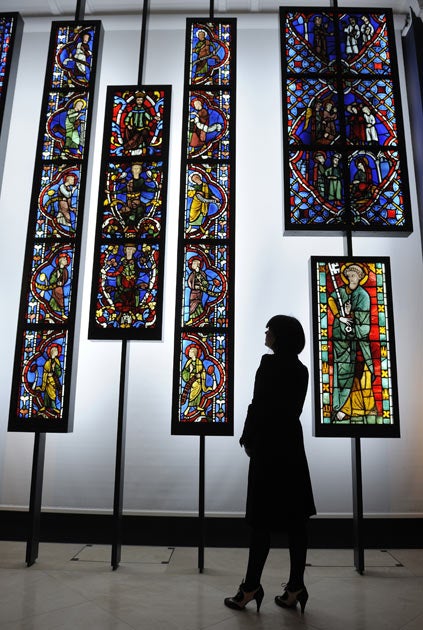Medieval and Renaissance Galleries, London
The V&A's 10 new galleries cost nearly £32m; they tell the story of a millennium of bling, from Coventry to Cremona

At the start of AS Byatt's novel The Children's Book, a young lad from the Potteries is found, in the 1890s, sketching a bizarre exhibit in the institution then still known as the South Kensington Museum. The homeless runaway will grow up to become a pioneering artist-potter, while the treasures of the museum – soon to be extended as the V&A – cast a permanent spell over the novel's major characters. And the object? You will find it in the "Faiths and Empires" section of the sumptuous new Medieval and Renaissance Galleries, 10 beautifully lit but densely packed spaces that the V&A's latest makeover has created at a price-tag of nearly £32m, with almost £10m from the Heritage Lottery Fund.
Fashioned in a silver-rich copper alloy, in around 1110 for Abbot Peter, the Gloucester Candlestick swarms with intricate foliage and mythical beasts. It's a riot of the kind of "Gothic" decoration that intrigued, and inspired, the Arts and Crafts intellectuals who people Byatt's book, and which the new galleries showcase in abundance. A soundbite summary of the new displays, conceived by chief curator Peta Motture and her team, might focus on the continuities and connections evident in every room. From the fall of Rome to the age of discovery, Europe adores – and bankrolls – a tradition of crafty sophistication and material extravagance. Century on century, it finds virtue in virtuosity.
So we move through more than a millennium of European arts, from 300 to 1600, and across a dizzying range of forms and techniques that takes in sculpture, textiles, ceramics, works in glass, wood and metal, furniture and painting. These riches stretch in origin from Yorkshire to Byzantium, and in size from a gemstone pendant to an entire chapel, taken from a convent in Florence.
From the exquisite late-Roman ivory of the Symmachi panel to the Venetian bowls and German gameboards that date from the end of this vast span of time, close-focus, labour-intensive craft in rich and rare materials enhance the renown of patrons sacred and secular: temples, churches, monasteries, nobles, monarchs and (always and everywhere) merchants. Whatever their dedication to the greater glory of God, many of the finest objects here – from Hubert Gerhard's gilded altar decorations to Vasari's tapestries – polished the images of such super-rich dynasties as the Fuggers and Medicis. This is where bankers' bonuses went. One minor figure struck me as the presiding deity of the whole shebang, and he had little to do with chapels and convents. In one corner stands a small portrait from around 1450 of Marco Barbarigo, Venetian consul in London and a future Doge. Shrewd, hard, practical, his is the face of the international trade that sought, and found, lustre and longevity in art.
Byatt's novel shows just how strong a role the V&A played in broadening public taste to rehabilitate the "grotesque" ornament of medieval arts. With an emphasis on a smooth-ish transition from Romanesque and Gothic to Renaissance styles, these new galleries sustain that mission. Artistic arbiters with strict Classical – or High Modernist – yardsticks hold little sway these days, and so the curators are rather pushing at an open door. Indeed, some of the most memorable highlights come in just those works where the late Middle Ages tremble in luxury and elegance on the brink of some kind of breakdown or breakthrough: as in the extraordinary "Boar and Bear Hunt" tapestry from the southern Netherlands in the 1420s.
Europe, any visiting alien would conclude, just loves a good yarn. A perpetual soap opera of soldiers and saints, lovers and heroes, hunts and trysts, unrolls in every medium to hand. Narratives of all sorts seethe and spread, from the biblical figures embroidered on English church stoles to the tale of Tristan and Isolde on a German wall hanging and the nativities and crucifixions chipped into marble, engraved on glass, illuminated on manuscripts and carved into wood from Coventry to Cremona.
To our quizzical extraterrestrial, the once-orthodox – but now largely discredited – distinctions between the outlook of the "Middle Ages" and "Renaissance" would seem mere nit-picking. Gaudy, ostentatious, magnificent, Europe's civilisation over a long millennium would appear to any cool outsider as one big empire of bling. Strangers, too, bring their arts to our lavish party. We see carpets from Turkey and Egypt, a gorgeous inlaid casket from 1550s Ceylon and – the only item in this cornucopia that made me laugh – a beer-drinker's lidded tankard crafted around 1600 in Japan from black lacquer decorated with mother-of-pearl. As he sipped his sake, what did its maker make of his clients?
Charles Darwent is away
Join our commenting forum
Join thought-provoking conversations, follow other Independent readers and see their replies
Comments